Measuring accuracy of XGBoost models
Contents
Measuring accuracy of XGBoost models#
(using stratified 5-fold cross validation, and a model with 8 features)
Plain English summary#
We have decided to simplify our model by using 8 independent features to predict which patients recieve thrombolysis. These are: arrival-to-scan time, infarction, stroke severity, precise onset time, prior disability level, stroke team, use of AF anticoagulents, and onset-to-arrival time. This gives a good balance of performance (in terms of ROC AUC, achieving 99.1% of what can be obtained with all 84 features) and model complexity.
There are many other ways in which to report model performance - in this notebook we will report on a range of these. The overall model accuracy is 84.7%, so just over 8 out of 10 instances will have a correct prediction. The model is also well calibrated (for example, all of the patients that a model predicts 40% probability for, 40% of them did recieve it).
Model and data#
XGBoost models were trained on stratified k-fold cross-validation data. The 8 features in the model are:
Arrival-to-scan time: Time from arrival at hospital to scan (mins)
Infarction: Stroke type (1 = infarction, 0 = haemorrhage)
Stroke severity: Stroke severity (NIHSS) on arrival
Precise onset time: Onset time type (1 = precise, 0 = best estimate)
Prior disability level: Disability level (modified Rankin Scale) before stroke
Stroke team: Stroke team attended
Use of AF anticoagulents: Use of atrial fibrillation anticoagulant (1 = Yes, 0 = No)
Onset-to-arrival time: Time from onset of stroke to arrival at hospital (mins)
And one target feature:
Thrombolysis: Recieve thrombolysis (1 = Yes, 0 = No)
The 8 features included in the model (to predict whether a patient will recieve thrombolysis) were chosen sequentially as having the single best improvement in model performance (using the ROC AUC). The stroke team feature is included as a one-hot encoded feature.
Aims#
Measure a range of accuracy scores (e.g. accuracy, sensitivity, specificity, F1, etc).
Plot Receiver Operator Characteristic Curve and measure AUC.
Identify cross-over point of sensitivity and specificity.
Save individual patient predictions.
Compare predicted and observed thrombolysis use at each hospital.
Examine learning curves
Check model calibration.
Observations#
Overall accuracy = 84.7% (88.3 for those 69% samples with at least 80% confidence of model)
Using nominal threshold (50% probability), specificity (89.4%) is greater than sensitivity (74.1%)
The model can achieve 83.7% sensitivity and specificity simultaneously
ROC AUC = 0.916
The model is well calibrated
Import libraries#
# Turn warnings off to keep notebook tidy
import warnings
warnings.filterwarnings("ignore")
import os
import matplotlib.pyplot as plt
from matplotlib.lines import Line2D
import numpy as np
import pandas as pd
from xgboost import XGBClassifier
from sklearn.metrics import auc
from sklearn.metrics import roc_curve
from sklearn.linear_model import LinearRegression
from sklearn import metrics
from imblearn.over_sampling import RandomOverSampler
import json
Set modifications to apply#
use_minority_oversampling = False
# Set model type (used in file save, e.g. xgb_combined_calibrated_oversampled)
model_type = 'xgb_combined_key_features'
Create output folders if needed#
path = './output'
if not os.path.exists(path):
os.makedirs(path)
path = './predictions'
if not os.path.exists(path):
os.makedirs(path)
Read in JSON file#
Contains a dictionary for plain English feature names for the 8 features selected in the model. Use these as the column titles in the DataFrame.
with open("./output/feature_name_dict.json") as json_file:
feature_name_dict = json.load(json_file)
Load data#
Data has previously been split into 5 stratified k-fold splits.
data_loc = '../data/kfold_5fold/'
# Initialise empty lists
train_data, test_data = [], []
# Read in the names of the selected features for the model
number_of_features_to_use = 8
key_features = pd.read_csv('./output/feature_selection.csv')
key_features = list(key_features['feature'])[:number_of_features_to_use]
# And add the target feature name: S2Thrombolysis
key_features.append("S2Thrombolysis")
for i in range(5):
train = pd.read_csv(data_loc + 'train_{0}.csv'.format(i))
train = train[key_features]
train.rename(columns=feature_name_dict, inplace=True)
train_data.append(train)
test = pd.read_csv(data_loc + 'test_{0}.csv'.format(i))
test = test[key_features]
test.rename(columns=feature_name_dict, inplace=True)
test_data.append(test)
Functions#
Calculate accuracy measures#
def calculate_accuracy(observed, predicted):
"""
Calculates a range of accuracy scores from observed and predicted classes.
Takes two list or NumPy arrays (observed class values, and predicted class
values), and returns a dictionary of results.
1) observed positive rate: proportion of observed cases that are +ve
2) Predicted positive rate: proportion of predicted cases that are +ve
3) observed negative rate: proportion of observed cases that are -ve
4) Predicted negative rate: proportion of predicted cases that are -ve
5) accuracy: proportion of predicted results that are correct
6) precision: proportion of predicted +ve that are correct
7) recall: proportion of true +ve correctly identified
8) f1: harmonic mean of precision and recall
9) sensitivity: Same as recall
10) specificity: Proportion of true -ve identified:
11) positive likelihood: increased probability of true +ve if test +ve
12) negative likelihood: reduced probability of true +ve if test -ve
13) false positive rate: proportion of false +ves in true -ve patients
14) false negative rate: proportion of false -ves in true +ve patients
15) true positive rate: Same as recall
16) true negative rate: Same as specificity
17) positive predictive value: chance of true +ve if test +ve
18) negative predictive value: chance of true -ve if test -ve
"""
# Converts list to NumPy arrays
if type(observed) == list:
observed = np.array(observed)
if type(predicted) == list:
predicted = np.array(predicted)
# Calculate accuracy scores
observed_positives = observed == 1
observed_negatives = observed == 0
predicted_positives = predicted == 1
predicted_negatives = predicted == 0
true_positives = (predicted_positives == 1) & (observed_positives == 1)
false_positives = (predicted_positives == 1) & (observed_positives == 0)
true_negatives = (predicted_negatives == 1) & (observed_negatives == 1)
false_negatives = (predicted_negatives == 1) & (observed_negatives == 0)
accuracy = np.mean(predicted == observed)
precision = (np.sum(true_positives) /
(np.sum(true_positives) + np.sum(false_positives)))
recall = np.sum(true_positives) / np.sum(observed_positives)
sensitivity = recall
f1 = 2 * ((precision * recall) / (precision + recall))
specificity = np.sum(true_negatives) / np.sum(observed_negatives)
positive_likelihood = sensitivity / (1 - specificity)
negative_likelihood = (1 - sensitivity) / specificity
false_positive_rate = 1 - specificity
false_negative_rate = 1 - sensitivity
true_positive_rate = sensitivity
true_negative_rate = specificity
positive_predictive_value = (np.sum(true_positives) /
(np.sum(true_positives) + np.sum(false_positives)))
negative_predictive_value = (np.sum(true_negatives) /
(np.sum(true_negatives) + np.sum(false_negatives)))
# Create dictionary for results, and add results
results = dict()
results['observed_positive_rate'] = np.mean(observed_positives)
results['observed_negative_rate'] = np.mean(observed_negatives)
results['predicted_positive_rate'] = np.mean(predicted_positives)
results['predicted_negative_rate'] = np.mean(predicted_negatives)
results['accuracy'] = accuracy
results['precision'] = precision
results['recall'] = recall
results['f1'] = f1
results['sensitivity'] = sensitivity
results['specificity'] = specificity
results['positive_likelihood'] = positive_likelihood
results['negative_likelihood'] = negative_likelihood
results['false_positive_rate'] = false_positive_rate
results['false_negative_rate'] = false_negative_rate
results['true_positive_rate'] = true_positive_rate
results['true_negative_rate'] = true_negative_rate
results['positive_predictive_value'] = positive_predictive_value
results['negative_predictive_value'] = negative_predictive_value
return results
Fit model#
XGBoost models were trained on stratified k-fold cross-validation data
# Set up list to store models and calibarion threshold
models = []
# Set up lists for observed and predicted
observed = []
predicted_proba = []
predicted = []
# Set up list for feature importances
feature_importance = []
# Loop through k folds
for k_fold in range(5):
# Get k fold split
train = train_data[k_fold]
test = test_data[k_fold]
# Get X and y
X_train = train.drop("Thrombolysis", axis=1)
X_test = test.drop("Thrombolysis", axis=1)
y_train = train["Thrombolysis"]
y_test = test["Thrombolysis"]
# Use oversampling if required
if use_minority_oversampling:
oversample = RandomOverSampler(sampling_strategy='minority')
X_train, y_train = oversample.fit_resample(X_train, y_train)
# One hot encode hospitals
X_train_hosp = pd.get_dummies(X_train['Stroke team'], prefix = 'team')
X_train = pd.concat([X_train, X_train_hosp], axis=1)
X_train.drop('Stroke team', axis=1, inplace=True)
X_test_hosp = pd.get_dummies(X_test['Stroke team'], prefix = 'team')
X_test = pd.concat([X_test, X_test_hosp], axis=1)
X_test.drop('Stroke team', axis=1, inplace=True)
# Define model
model = XGBClassifier(verbosity = 0, seed=42, learning_rate=0.5)
# Fit model
model.fit(X_train, y_train)
models.append(model)
# Get predicted probabilities
y_probs = model.predict_proba(X_test)[:,1]
observed.append(y_test)
predicted_proba.append(y_probs)
# Get feature importances
importance = model.feature_importances_
feature_importance.append(importance)
# Get class
y_class = y_probs >= 0.5
y_class = np.array(y_class) * 1.0
predicted.append(y_class)
# Print accuracy
accuracy = np.mean(y_class == y_test)
print (
f'Run {k_fold}, accuracy: {accuracy:0.3f}')
Run 0, accuracy: 0.846
Run 1, accuracy: 0.853
Run 2, accuracy: 0.845
Run 3, accuracy: 0.849
Run 4, accuracy: 0.844
Results#
Accuracy measures#
# Set up list for results
k_fold_results = []
# Loop through k fold predictions and get accuracy measures
for i in range(5):
results = calculate_accuracy(observed[i], predicted[i])
k_fold_results.append(results)
# Put results in DataFrame
accuracy_results = pd.DataFrame(k_fold_results).T
accuracy_results
| 0 | 1 | 2 | 3 | 4 | |
|---|---|---|---|---|---|
| observed_positive_rate | 0.295963 | 0.295737 | 0.295867 | 0.295529 | 0.295472 |
| observed_negative_rate | 0.704037 | 0.704263 | 0.704133 | 0.704471 | 0.704528 |
| predicted_positive_rate | 0.291570 | 0.291458 | 0.294121 | 0.292037 | 0.295022 |
| predicted_negative_rate | 0.708430 | 0.708542 | 0.705879 | 0.707963 | 0.704978 |
| accuracy | 0.846275 | 0.852582 | 0.844746 | 0.849420 | 0.844239 |
| precision | 0.743917 | 0.754444 | 0.739039 | 0.748168 | 0.736782 |
| recall | 0.732877 | 0.743526 | 0.734678 | 0.739329 | 0.735658 |
| f1 | 0.738355 | 0.748945 | 0.736852 | 0.743722 | 0.736220 |
| sensitivity | 0.732877 | 0.743526 | 0.734678 | 0.739329 | 0.735658 |
| specificity | 0.893945 | 0.898377 | 0.890995 | 0.895604 | 0.889777 |
| positive_likelihood | 6.910375 | 7.316509 | 6.739852 | 7.081937 | 6.674273 |
| negative_likelihood | 0.298814 | 0.285486 | 0.297781 | 0.291056 | 0.297087 |
| false_positive_rate | 0.106055 | 0.101623 | 0.109005 | 0.104396 | 0.110223 |
| false_negative_rate | 0.267123 | 0.256474 | 0.265322 | 0.260671 | 0.264342 |
| true_positive_rate | 0.732877 | 0.743526 | 0.734678 | 0.739329 | 0.735658 |
| true_negative_rate | 0.893945 | 0.898377 | 0.890995 | 0.895604 | 0.889777 |
| positive_predictive_value | 0.743917 | 0.754444 | 0.739039 | 0.748168 | 0.736782 |
| negative_predictive_value | 0.888403 | 0.892951 | 0.888791 | 0.891187 | 0.889208 |
accuracy_results.T.describe()
| observed_positive_rate | observed_negative_rate | predicted_positive_rate | predicted_negative_rate | accuracy | precision | recall | f1 | sensitivity | specificity | positive_likelihood | negative_likelihood | false_positive_rate | false_negative_rate | true_positive_rate | true_negative_rate | positive_predictive_value | negative_predictive_value | |
|---|---|---|---|---|---|---|---|---|---|---|---|---|---|---|---|---|---|---|
| count | 5.000000 | 5.000000 | 5.000000 | 5.000000 | 5.000000 | 5.000000 | 5.000000 | 5.000000 | 5.000000 | 5.000000 | 5.000000 | 5.000000 | 5.000000 | 5.000000 | 5.000000 | 5.000000 | 5.000000 | 5.000000 |
| mean | 0.295714 | 0.704286 | 0.292842 | 0.707158 | 0.847452 | 0.744470 | 0.737214 | 0.740819 | 0.737214 | 0.893740 | 6.944589 | 0.294045 | 0.106260 | 0.262786 | 0.737214 | 0.893740 | 0.744470 | 0.890108 |
| std | 0.000211 | 0.000211 | 0.001625 | 0.001625 | 0.003508 | 0.007107 | 0.004242 | 0.005418 | 0.004242 | 0.003473 | 0.261413 | 0.005660 | 0.003473 | 0.004242 | 0.004242 | 0.003473 | 0.007107 | 0.001917 |
| min | 0.295472 | 0.704037 | 0.291458 | 0.704978 | 0.844239 | 0.736782 | 0.732877 | 0.736220 | 0.732877 | 0.889777 | 6.674273 | 0.285486 | 0.101623 | 0.256474 | 0.732877 | 0.889777 | 0.736782 | 0.888403 |
| 25% | 0.295529 | 0.704133 | 0.291570 | 0.705879 | 0.844746 | 0.739039 | 0.734678 | 0.736852 | 0.734678 | 0.890995 | 6.739852 | 0.291056 | 0.104396 | 0.260671 | 0.734678 | 0.890995 | 0.739039 | 0.888791 |
| 50% | 0.295737 | 0.704263 | 0.292037 | 0.707963 | 0.846275 | 0.743917 | 0.735658 | 0.738355 | 0.735658 | 0.893945 | 6.910375 | 0.297087 | 0.106055 | 0.264342 | 0.735658 | 0.893945 | 0.743917 | 0.889208 |
| 75% | 0.295867 | 0.704471 | 0.294121 | 0.708430 | 0.849420 | 0.748168 | 0.739329 | 0.743722 | 0.739329 | 0.895604 | 7.081937 | 0.297781 | 0.109005 | 0.265322 | 0.739329 | 0.895604 | 0.748168 | 0.891187 |
| max | 0.295963 | 0.704528 | 0.295022 | 0.708542 | 0.852582 | 0.754444 | 0.743526 | 0.748945 | 0.743526 | 0.898377 | 7.316509 | 0.298814 | 0.110223 | 0.267123 | 0.743526 | 0.898377 | 0.754444 | 0.892951 |
Receiver Operator Characteristic and Sensitivity-Specificity Curves#
Receiver Operator Characteristic Curve:
# Set up lists for results
k_fold_fpr = [] # false positive rate
k_fold_tpr = [] # true positive rate
k_fold_thresholds = [] # threshold applied
k_fold_auc = [] # area under curve
# Loop through k fold predictions and get ROC results
for i in range(5):
fpr, tpr, thresholds = roc_curve(observed[i], predicted_proba[i])
roc_auc = auc(fpr, tpr)
k_fold_fpr.append(fpr)
k_fold_tpr.append(tpr)
k_fold_thresholds.append(thresholds)
k_fold_auc.append(roc_auc)
# Show mean area under curve
mean_auc = np.mean(k_fold_auc)
sd_auc = np.std(k_fold_auc)
print (f'\nMean AUC: {mean_auc:0.4f}')
print (f'SD AUC: {sd_auc:0.4f}')
Mean AUC: 0.9158
SD AUC: 0.0021
Calculate data for sensitivity-specificity curve:
k_fold_sensitivity = []
k_fold_specificity = []
for i in range(5):
# Get classificiation probabilities for k-fold replicate
obs = observed[i]
proba = predicted_proba[i]
# Set up list for accuracy measures
sensitivity = []
specificity = []
# Loop through increments in probability of survival
thresholds = np.arange(0.0, 1.01, 0.01)
for cutoff in thresholds: # loop 0 --> 1 on steps of 0.1
# Get classificiation using cutoff
predicted_class = proba >= cutoff
predicted_class = predicted_class * 1.0
# Call accuracy measures function
accuracy = calculate_accuracy(obs, predicted_class)
# Add accuracy scores to lists
sensitivity.append(accuracy['sensitivity'])
specificity.append(accuracy['specificity'])
# Add replicate to lists
k_fold_sensitivity.append(sensitivity)
k_fold_specificity.append(specificity)
Create a combined plot: ROC and sensitivity-specificity
fig = plt.figure(figsize=(10,5))
# Plot ROC
ax1 = fig.add_subplot(121)
for i in range(5):
ax1.plot(k_fold_fpr[i], k_fold_tpr[i], color='orange')
ax1.plot([0, 1], [0, 1], color='darkblue', linestyle='--')
ax1.set_xlabel('False Positive Rate')
ax1.set_ylabel('True Positive Rate')
ax1.set_title('Receiver Operator Characteristic Curve')
text = f'Mean AUC: {mean_auc:.3f}'
ax1.text(0.64,0.07, text,
bbox=dict(facecolor='white', edgecolor='black'))
plt.grid(True)
# Plot sensitivity-specificity
ax2 = fig.add_subplot(122)
for i in range(5):
ax2.plot(k_fold_sensitivity[i], k_fold_specificity[i])
ax2.set_xlabel('Sensitivity')
ax2.set_ylabel('Specificity')
ax2.set_title('Sensitivity-Specificity Curve')
plt.grid(True)
plt.tight_layout(pad=2)
plt.savefig(f'./output/{model_type}_roc_sens_spec.jpg', dpi=300)
plt.show()
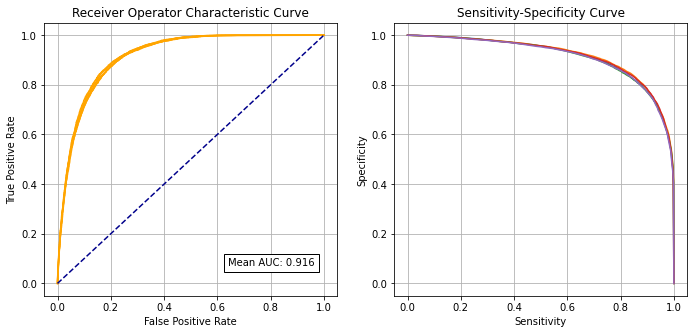
Identify cross-over point on sensitivity-specificity curve#
Adjusting the classification threshold allows us to balance sensitivity (the proportion of patients receiving thrombolysis correctly identified) and specificity (the proportion of patients not receiving thrombolysis correctly identified). An increase in sensitivity causes a loss in specificity (and vice versa). Here we identify the pint where specificity and sensitivity hold the same value.
def get_intersect(a1, a2, b1, b2):
"""
Returns the point of intersection of the lines passing through a2,a1 and b2,b1.
a1: [x, y] a point on the first line
a2: [x, y] another point on the first line
b1: [x, y] a point on the second line
b2: [x, y] another point on the second line
"""
s = np.vstack([a1,a2,b1,b2]) # s for stacked
h = np.hstack((s, np.ones((4, 1)))) # h for homogeneous
l1 = np.cross(h[0], h[1]) # get first line
l2 = np.cross(h[2], h[3]) # get second line
x, y, z = np.cross(l1, l2) # point of intersection
if z == 0: # lines are parallel
return (float('inf'), float('inf'))
return (x/z, y/z)
intersections = []
for i in range(5):
sens = np.array(k_fold_sensitivity[i])
spec = np.array(k_fold_specificity[i])
df = pd.DataFrame()
df['sensitivity'] = sens
df['specificity'] = spec
df['spec greater sens'] = spec > sens
# find last index for senitivity being greater than specificity
mask = df['spec greater sens'] == False
last_id_sens_greater_spec = np.max(df[mask].index)
locs = [last_id_sens_greater_spec, last_id_sens_greater_spec + 1]
points = df.iloc[locs][['sensitivity', 'specificity']]
# Get intersetction with line of x=y
a1 = list(points.iloc[0].values)
a2 = list(points.iloc[1].values)
b1 = [0, 0]
b2 = [1, 1]
intersections.append(get_intersect(a1, a2, b1, b2)[0])
mean_intersection = np.mean(intersections)
sd_intersection = np.std(intersections)
print (f'\nMean intersection: {mean_intersection:0.4f}')
print (f'SD intersection: {sd_intersection:0.4f}')
Mean intersection: 0.8370
SD intersection: 0.0035
Collate and save results#
hospital_results = []
kfold_result = []
observed_results = []
prob_results = []
predicted_results = []
for i in range(5):
hospital_results.extend(list(test_data[i]['Stroke team']))
kfold_result.extend(list(np.repeat(i, len(test_data[i]))))
observed_results.extend(list(observed[i]))
prob_results.extend(list(predicted_proba[i]))
predicted_results.extend(list(predicted[i]))
model_predictions = pd.DataFrame()
model_predictions['hospital'] = hospital_results
model_predictions['observed'] = np.array(observed_results) * 1.0
model_predictions['prob'] = prob_results
model_predictions['predicted'] = predicted_results
model_predictions['k_fold'] = kfold_result
model_predictions['correct'] = model_predictions['observed'] == model_predictions['predicted']
# Save
filename = f'./predictions/{model_type}_predictions.csv'
model_predictions.to_csv(filename, index=False)
# Save combined test set
combined_test_set = pd.concat(test_data, axis=0)
combined_test_set.reset_index(inplace=True); del combined_test_set['index']
combined_test_set.to_csv(f'./predictions/{model_type}_combined_test_features.csv')
Compare predicted and actual thrombolysis rates#
mean_results_by_hosp = model_predictions.groupby('hospital').mean()
Get r-square of predicted thrombolysis rate.
x_comparision = np.array(mean_results_by_hosp['observed']).reshape(-1, 1)
y_comparision = np.array(mean_results_by_hosp['predicted']).reshape(-1, 1)
slr = LinearRegression()
slr.fit(x_comparision, y_comparision)
y_pred = slr.predict(x_comparision)
r_square = metrics.r2_score(y_comparision, y_pred)
print(f'R squared {r_square:0.3f}')
R squared 0.966
fig = plt.figure(figsize=(6,6))
ax1 = fig.add_subplot(111)
ax1.scatter(x_comparision,
y_comparision)
plt.plot (x_comparision, slr.predict(x_comparision), color = 'red')
text = f'R squared: {r_square:.3f}'
ax1.text(0.33,0.13, text,
bbox=dict(facecolor='white', edgecolor='black'))
ax1.set_xlabel('Observed thrombolysis use (%)')
ax1.set_ylabel('Predicted thrombolysis use (%)')
plt.grid()
plt.savefig(f'output/{model_type}_observed_predicted_rates.jpg', dpi=300)
plt.show()
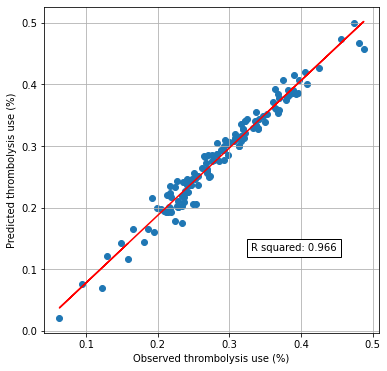
Feature Importances#
Get XGBoost feature importances (average across k-fold results)
# Feature names
features = X_test.columns.values
# Get average feature importance from k-fold
importances = np.array(feature_importance).mean(axis = 0)
feature_importance = pd.DataFrame(data = importances, index=features)
feature_importance.columns = ['importance']
# Sort by importance (weight)
feature_importance.sort_values(by='importance', ascending=False, inplace=True)
# Save
feature_importance.to_csv(f'output/{model_type}_feature_importance.csv')
# Display top 25
feature_importance.head(25)
| importance | |
|---|---|
| Infarction | 0.351191 |
| Use of AF anticoagulents | 0.047361 |
| Precise onset time | 0.028215 |
| team_MHMYL4920B | 0.012756 |
| Stroke severity | 0.012489 |
| Prior disability level | 0.011771 |
| team_GKONI0110I | 0.011207 |
| Arrival-to-scan time | 0.011024 |
| team_XKAWN3771U | 0.010322 |
| team_LECHF1024T | 0.010216 |
| team_QWKRA8499D | 0.009841 |
| team_NTPQZ0829K | 0.009365 |
| team_VKKDD9172T | 0.009130 |
| team_FAJKD7118X | 0.009070 |
| team_HYNBH3271L | 0.008574 |
| team_SMVTP6284P | 0.008030 |
| team_LGNPK4211W | 0.007826 |
| team_TPXYE0168D | 0.007692 |
| team_HBFCN1575G | 0.007633 |
| team_IYJHY1440E | 0.007351 |
| team_IAZKG9244A | 0.007343 |
| team_HZNVT9936G | 0.007322 |
| team_XDAFB7350M | 0.007283 |
| team_KZKEZ2257Z | 0.007136 |
| team_TKRKH4920C | 0.006752 |
Create a bar chart for the XGBoost feature importance values
# Set up figure
fig = plt.figure(figsize=(8,8))
ax = fig.add_subplot(111)
# Get labels and values
labels = feature_importance.index.values[0:25]
pos = np.arange(len(labels))
val = feature_importance['importance'].values[0:25]
# Plot
ax.bar(pos, val)
ax.set_ylabel('Feature importance')
ax.set_xticks(np.arange(len(labels)))
ax.set_xticklabels(labels)
# Rotate the tick labels and set their alignment.
plt.setp(ax.get_xticklabels(), rotation=90, ha="right",
rotation_mode="anchor")
plt.tight_layout()
plt.savefig(f'output/{model_type}_feature_weights_bar.jpg', dpi=300)
plt.show()
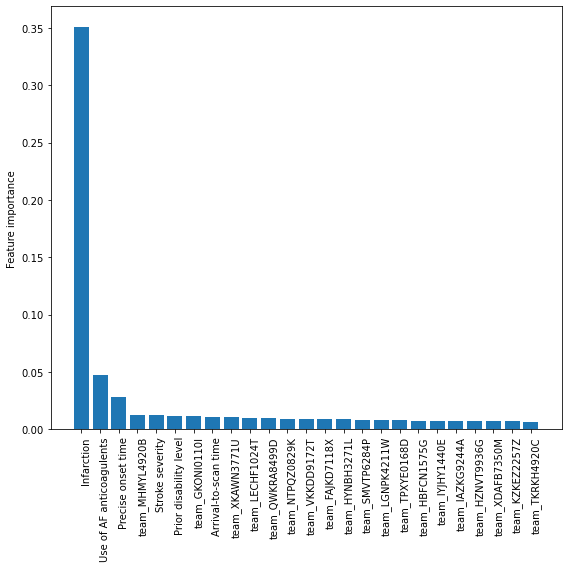
Calibration and assessment of accuracy when model has high confidence#
# Collate results in Dataframe
reliability_collated = pd.DataFrame()
# Loop through k fold predictions
for i in range(5):
# Get observed class and predicted probability
obs = observed[i]
prob = predicted_proba[i]
# Bin data with numpy digitize (this will assign a bin to each case)
step = 0.10
bins = np.arange(step, 1+step, step)
digitized = np.digitize(prob, bins)
# Put single fold data in DataFrame
reliability = pd.DataFrame()
reliability['bin'] = digitized
reliability['probability'] = prob
reliability['observed'] = obs
classification = 1 * (prob > 0.5 )
reliability['correct'] = obs == classification
reliability['count'] = 1
# Summarise data by bin in new dataframe
reliability_summary = pd.DataFrame()
# Add bins and k-fold to summary
reliability_summary['bin'] = bins
reliability_summary['k-fold'] = i
# Calculate mean of predicted probability of thrombolysis in each bin
reliability_summary['confidence'] = \
reliability.groupby('bin').mean()['probability']
# Calculate the proportion of patients who receive thrombolysis
reliability_summary['fraction_positive'] = \
reliability.groupby('bin').mean()['observed']
# Calculate proportion correct in each bin
reliability_summary['fraction_correct'] = \
reliability.groupby('bin').mean()['correct']
# Calculate fraction of results in each bin
reliability_summary['fraction_results'] = \
reliability.groupby('bin').sum()['count'] / reliability.shape[0]
# Add k-fold results to DatafRame collation
reliability_collated = reliability_collated.append(reliability_summary)
# Get mean results
reliability_summary = reliability_collated.groupby('bin').mean()
reliability_summary.drop('k-fold', axis=1, inplace=True)
reliability_summary
| confidence | fraction_positive | fraction_correct | fraction_results | |
|---|---|---|---|---|
| bin | ||||
| 0.1 | 0.018412 | 0.023867 | 0.976133 | 0.472306 |
| 0.2 | 0.145836 | 0.164487 | 0.835513 | 0.086280 |
| 0.3 | 0.247578 | 0.271592 | 0.728408 | 0.058316 |
| 0.4 | 0.349648 | 0.367141 | 0.632859 | 0.047853 |
| 0.5 | 0.448994 | 0.444480 | 0.555520 | 0.042402 |
| 0.6 | 0.550910 | 0.546004 | 0.546004 | 0.043506 |
| 0.7 | 0.652850 | 0.635854 | 0.635854 | 0.051615 |
| 0.8 | 0.752323 | 0.747044 | 0.747044 | 0.064285 |
| 0.9 | 0.851260 | 0.824061 | 0.824061 | 0.085334 |
| 1.0 | 0.932336 | 0.896424 | 0.896424 | 0.048101 |
Plot results:
fig = plt.figure(figsize=(10,5))
# Plot predicted prob vs fraction psotive
ax1 = fig.add_subplot(1,2,1)
# Loop through k-fold reliability results
for i in range(5):
mask = reliability_collated['k-fold'] == i
k_fold_result = reliability_collated[mask]
x = k_fold_result['confidence']
y = k_fold_result['fraction_positive']
ax1.plot(x,y, color='orange')
# Add 1:1 line
ax1.plot([0,1],[0,1], color='k', linestyle ='--')
# Refine plot
ax1.set_xlabel('Model probability')
ax1.set_ylabel('Fraction positive')
ax1.set_xlim(0, 1)
ax1.set_ylim(0, 1)
# Plot accuracy vs probability
ax2 = fig.add_subplot(1,2,2)
# Loop through k-fold reliability results
for i in range(5):
mask = reliability_collated['k-fold'] == i
k_fold_result = reliability_collated[mask]
x = k_fold_result['confidence']
y = k_fold_result['fraction_correct']
ax2.plot(x,y, color='orange')
# Refine plot
ax2.set_xlabel('Model probability')
ax2.set_ylabel('Fraction correct')
ax2.set_xlim(0, 1)
ax2.set_ylim(0, 1)
# instantiate a second axes that shares the same x-axis
ax3 = ax2.twinx()
for i in range(5):
mask = reliability_collated['k-fold'] == i
k_fold_result = reliability_collated[mask]
x = k_fold_result['confidence']
y = k_fold_result['fraction_results']
ax3.plot(x,y, color='blue')
ax3.set_xlim(0, 1)
ax3.set_ylim(0, 0.5)
ax3.set_ylabel('Fraction of samples')
custom_lines = [Line2D([0], [0], color='orange', alpha=0.6, lw=2),
Line2D([0], [0], color='blue', alpha = 0.6,lw=2)]
ax1.grid()
ax2.grid()
plt.legend(custom_lines, ['Fraction correct', 'Fraction of samples'],
loc='upper center')
plt.tight_layout(pad=2)
plt.savefig(f'./output/{model_type}_reliability.jpg', dpi=300)
plt.show()
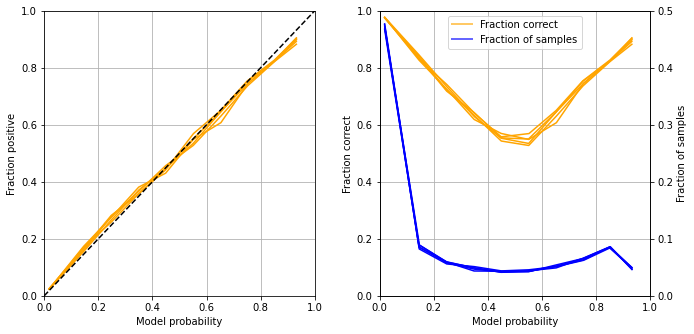
Get accuracy of model when model is at least 80% confident
bins = [0.1, 0.2, 0.9, 1.0]
acc = reliability_summary.loc[bins].mean()['fraction_correct']
frac = reliability_summary.loc[bins].sum()['fraction_results']
print ('For samples with at least 80% confidence:')
print (f'Proportion of all samples: {frac:0.3f}')
print (f'Accuracy: {acc:0.3f}')
For samples with at least 80% confidence:
Proportion of all samples: 0.692
Accuracy: 0.883
Check for predicted thrombolysis in test set#
mask = combined_test_set['Infarction'] == 0
haemorrhagic_test = model_predictions['predicted'][mask]
count = len(haemorrhagic_test)
pos = haemorrhagic_test.sum()
print (f'{pos:.0f} predicted thrombolysis out of {count} haemorrhagic strokes')
0 predicted thrombolysis out of 13243 haemorrhagic strokes
Learning curve#
Examine the relationship between training data size and accuracy.
Plot learning curve
# Set up list to collect results
results_training_size = []
results_accuracy = []
results_all_accuracy = []
# Get maximum training size (number of training records)
max_training_size = train_data[0].shape[0]
# Construct training sizes (values closer at lower end)
train_sizes = [50, 100, 250, 500, 1000, 2500]
for i in range (5000, max_training_size, 5000):
train_sizes.append(i)
# Loop through training sizes
for train_size in train_sizes:
# Record accuracy across k-fold replicates
replicate_accuracy = []
for replicate in range(5):
# Get training and test data (from first k-fold split)
train = train_data[0]
test = test_data[0]
# One hot encode hospitals
train_hosp = pd.get_dummies(train['Stroke team'], prefix = 'team')
train = pd.concat([train, train_hosp], axis=1)
train.drop('Stroke team', axis=1, inplace=True)
test_hosp = pd.get_dummies(test['Stroke team'], prefix = 'team')
test = pd.concat([test, test_hosp], axis=1)
test.drop('Stroke team', axis=1, inplace=True)
# Sample from training data
train = train.sample(n=train_size)
# Get X and y
X_train = train.drop('Thrombolysis', axis=1)
X_test = test.drop('Thrombolysis', axis=1)
y_train = train['Thrombolysis']
y_test = test['Thrombolysis']
# Define model
model = XGBClassifier(verbosity = 0, seed=42, learning_rate=0.5)
# Fit model
model.fit(X_train, y_train)
# Predict test set
y_pred_test = model.predict(X_test)
# Get accuracy and record results
accuracy = np.mean(y_pred_test == y_test)
replicate_accuracy.append(accuracy)
results_all_accuracy.append(accuracy)
# Store mean accuracy across the k-fold splits
results_accuracy.append(np.mean(replicate_accuracy))
results_training_size.append(train_size)
k_fold_accuracy = np.array(results_all_accuracy).reshape(len(train_sizes), 5)
fig = plt.figure(figsize=(10,5))
ax1 = fig.add_subplot(121)
for i in range(5):
ax1.plot(results_training_size, k_fold_accuracy[:, i])
ax1.set_xlabel('Training set size')
ax1.set_ylabel('Accuracy)')
ax1.grid()
# Focus on first 5000
ax2 = fig.add_subplot(122)
for i in range(5):
ax2.plot(results_training_size, k_fold_accuracy[:, i])
ax2.set_xlabel('Training set size')
ax2.set_ylabel('Accuracy')
ax2.set_xlim(0, 5000)
ax2.grid()
plt.tight_layout()
plt.savefig(f'./output/{model_type}_learning_curve.jpg', dpi=300)
plt.show()
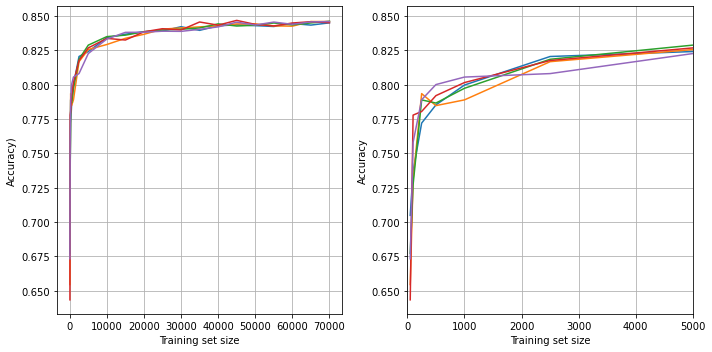
Observations#
Overall accuracy = 84.7% (88.3 for those 69% samples with at least 80% confidence of model)
Using nominal threshold (50% probability), specificity (89.4%) is greater than sensitivity (74.1%)
The model can achieve 83.7% sensitivity and specificity simultaneously
ROC AUC = 0.916
The model is well calibrated